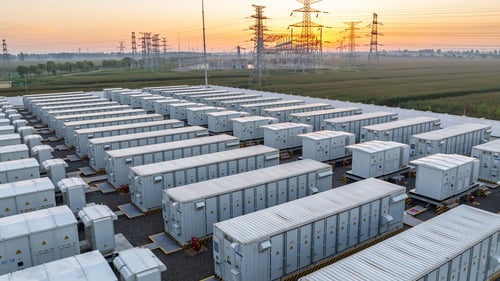Five Myths About Demand Response, Debunked!

Jump to:
- Myth #1: Demand Response Disrupts Core Processes
- Myth #2: Demand Response Impacts Deadlines
- Myth #3: Plant Managers Lose Control Over Their Machinery
- Myth #4: The Return on Investment Isn’t Worth It
- Myth #5: Demand Response Can Compromise Assets
Myth #1: Demand Response Disrupts Core Processes

Any business’ main concern is avoiding disrupting its production lines, which can translate into wasted material, time, and money loss. Those with this concern are businesses with sensitive processes, like food manufacturing, who have temperature-sensitive operations.
The Reality
Demand response programmes offer granular control, allowing specific minimum and maximum allowable changes to critical equipment. This ensures that product quality remains unaffected during activations.
Another way to ensure no disruption to production is through pre-cooling/heating strategies. Certain assets, like e-boilers, are able to retain heat despite being turned on or off, ensuring that their functionality can be used in a business's core operations. This “buffer” that they create, makes them ideal assets for demand response.
Myth #2: Demand Response Impacts Deadlines
Companies that rely on heavy machinery, like those in construction or manufacturing, fear that reducing energy use might power down equipment or halting production lines, leading to delays in meeting deadlines and potentially impacting customer satisfaction.
The Reality
The goal of demand response is to reduce non-critical energy use and use that flexibility to balance grid disturbances. Flexibility services providers, like Sympower, work closely with businesses to identify how many megawatts (MW) they’re able to provide without affecting their core processes.
In the case of their customer, Boliden, two tests were on their primary and secondary mills. It was discovered that the extra revenue from being available far surpassed the production loss. This gave Boliden the confidence to connect 8MW to the FCR-D Up programme in Sweden.
Myth #3: Plant Managers Lose Control Over Their Machinery

Some businesses hesitate to give control over their assets to a third party. They worry about the consequences of giving another company the ability to turn on and off their assets for demand response activations.
The Reality
Demand response experts understand business production cycles. They work closely with plant managers and energy teams to plan demand response activations strategically, minimise disruptions, and maximise revenues from demand response.
This involves companies deciding what equipment is used for demand response. Flexibility service providers what equipment can be activated, while companies know how this will ultimately impact their processes. Once this has been established and the assets are live, companies can choose which hours they participate in, or are given clear notifications in advance to adjust their processes accordingly.
Myth #4: The Return on Investment Isn’t Worth It

While the financial gain from participating in demand response programmes sounds attractive, is the potential disruption worth the reward? Scepticism can exist about the accuracy of forecasts or the overall profitability of such programmes.
The Reality
Earning revenue with demand response can be a very lucrative opportunity for companies. The more MW a business can make available, the more revenue they earn. Usually, this occurs in two forms. One, is payment for availability, where businesses are compensated for making their assets available for demand response even if they are not activated. Two, is payment for activation, in which businesses are compensated when their assets are active for demand response.
The prices are based on market price at the time of delivery. Using sophisticated software, flexibility services providers maximise the value of assets through daily forecasting and bidding on balancing markets.
Myth #5: Demand Response Can Compromise Assets

Though a company may know that its core processes will not be disrupted, it might still worry that its assets' physical integrity may be compromised. There is concern that demand response will physically alter its assets, resulting in decreased efficiency or complete failure.
The Reality
Unlike traditional methods that require physical adjustments to equipment, demand response works through an external signal. This means a company’s internal IT infrastructure remains completely isolated from demand response operations. However, it’s also important to weigh the costs and benefits of demand response when participating.
Flexibility service providers clearly communicate the expected amount and length of activations. This allows companies to analyse the lifetime of an asset, as well as the risk of breakdowns from being turned on and off more often than usual. Companies are informed of this so they can evaluate which asset are best suited for demand response, calculate the potential additional revenue, and make an informed decision about the overall benefit of participating.
Demand response isn’t a new concept, but until recently it was closed off to commercial and industrial businesses. This explains why these myths are still out there. Thankfully, flexibility service providers, like Sympower, are experts in demand response. They ensure zero impact occurs to your processes, while creating the greatest potential for their customers.
Other articles you might find interesting
-
 Demand-side flexibility16 October 2024
Demand-side flexibility16 October 2024District Heating Operators: New Revenue From Grid Balancing
Read more -
 Demand-side flexibility16 October 2024
Demand-side flexibility16 October 2024BESS & Demand Response, What’s the Connection?
Read more -
.jpg?length=500&name=Article%20Thumbnails%20-%201920x1080%20new%20website%20(4).jpg) Demand-side flexibility16 October 2024
Demand-side flexibility16 October 20243 Things to Look for in a Flexibility Service Provider
Read more -
.jpg?length=500&name=Article%20Thumbnails%20-%201920x1080%20new%20website%20(35).jpg) Demand-side flexibility16 October 2024
Demand-side flexibility16 October 2024smartEn Executive Director Michael Villa on the future of energy flexibility in Europe
Read more -
.jpg?length=500&name=Article%20Thumbnails%20-%201920x1080%20new%20website%20(34).jpg) demand response16 October 2024
demand response16 October 2024Getting Europe’s Grids Fit for the 21st Century - Interview With SmartEn’s Executive Director Michael Villa
Read more -
 Demand-side flexibility16 October 2024
Demand-side flexibility16 October 2024Empowering Industry through Energy Flexibility - Q&A with Raphaël Gras
Read more -
 demand response16 October 2024
demand response16 October 2024EU elections: Opportunity or Risk for Demand-Side Flexibility? - Q&A with Mathilde Chareyron
Read more -
 Energy management16 October 2024
Energy management16 October 2024Going From Passive to Active as an Energy Consumer - Q&A with Gianluca Rimini
Read more -
.jpg?length=500&name=Article%20Thumbnails%20-%201920x1080%20new%20website%20(5).jpg) Knowledge16 October 2024
Knowledge16 October 2024How to Earn Revenue with Demand Response
Read more -
.jpg?length=500&name=Article%20Thumbnails%20-%201920x1080%20new%20website%20(6).jpg) Demand-side flexibility16 October 2024
Demand-side flexibility16 October 2024Five Times Demand Response Saved the Grid
Read more -
.jpg?length=500&name=Article%20Thumbnails%20-%201920x1080%20new%20website%20(9).jpg) Energy markets16 October 2024
Energy markets16 October 2024Why do Energy Prices Change?
Read more -
.jpg?length=500&name=Article%20Thumbnails%20-%201920x1080%20new%20website%20(12).jpg) electrification16 October 2024
electrification16 October 2024What are Energy Markets?
Read more
